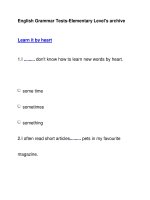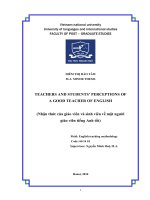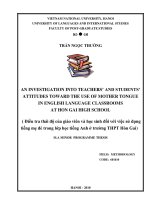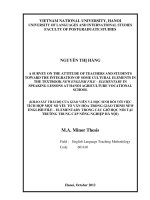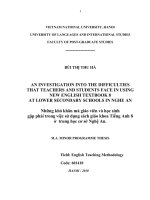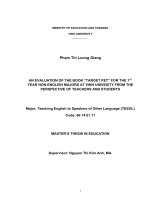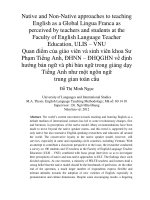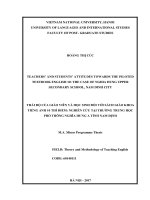Fun with english grammar
Bạn đang xem bản rút gọn của tài liệu. Xem và tải ngay bản đầy đủ của tài liệu tại đây (4.68 MB, 365 trang )
Fun
Suzanne W. Woodward
Fun
PRENTICE HALL REGENTS
Upper Saddle River, NJ 07458
with
Grammar
Communicative
Activities
for the
Azar Grammar
Series
DEDICATED TO
Kyle, Scott, and Sarah
Publisher: Mary Jane Peluso
Editor: Stella Reilly
Development Editor: Janet Johnston
Production Editor/Electronic Page Composition: Nicole Cypher
Interior Design: Wanda España, Merle Krumper
Manufacturing Manager: Ray Keating
Art Director: Merle Krumper
Art Production: Marita Froimson
All rights reserved. No part of this book may be
reproduced, in any form or by any means, without
permission in writing from the publisher.
Printed in the United States of America
10987654321
ISBN 0-13-567926-5
Prentice-Hall International (UK) Limited, London
Prentice-Hall of Australia Pty. Limited, Sydney
Prentice-Hall Canada Inc., Toronto
Prentice-Hall Hispañoamericana, S.A., Mexico
Prentice-Hall of India Private Limited, New Delhi
Prentice-Hall of Japan, Inc., Tokyo
Simon & Schuster Asia Pte. Ltd., Singapore
Editora Prentice-Hall do Brasil, Ltda., Rio de Janeiro
© 1997 by PRENTICE HALL REGENTS
Prentice-Hall, Inc.
A Simon & Schuster Company
Upper Saddle River, New Jersey 07458
PRENTICE HALL REGENTS
iii
Contents
Foreword by Betty Schrampfer Azar................................................vi
To the Teacher ......................................................................................vii
Acknowledgments ................................................................................xii
Chapter 1 VERBS –– PRESENT
SIMPLE PRESENT ..............................................................................2
NONPROGRESSIVES ........................................................................11
PRESENT PROGRESSIVE ..................................................................12
WORKSHEETS 1 – 9 ......................................................................16
Chapter 2 VERBS –– PAST
SIMPLE PAST ..................................................................................26
IRREGULAR PAST FORMS ................................................................30
PAST PROGRESSIVE ........................................................................36
PRESENT PERFECT..........................................................................38
PAST PERFECT ................................................................................40
PAST REVIEW ................................................................................41
WORKSHEETS 10 – 21....................................................................43
Chapter 3 VERBS –– FUTURE
PREDICTIONS ................................................................................64
WILLINGNESS ................................................................................68
PRIOR PLAN ..................................................................................69
PREDICTIONS, PRIOR PLANS, OR WILLINGNESS ................................71
FUTURE IN TIME CLAUSES ..............................................................72
FUTURE PROGRESSIVE AND FUTURE TIME CLAUSES ..........................73
FUTURE PERFECT ............................................................................73
WORKSHEETS 22 – 27B ................................................................75
Chapter 4 VERBS –– REVIEW
REVIEW OF PERFECT TENSES ..........................................................89
REVIEW OF ALL VERB FORMS ..........................................................90
WORKSHEETS 28A – 32B ..............................................................96
Chapter 5 QUESTIONS
YES / NO
QUESTIONS ....................................................................105
INFORMATION QUESTIONS ............................................................109
INFORMATION QUESTIONS AND/OR
YES / NO
QUESTIONS ................112
TAG QUESTIONS ..........................................................................116
WORKSHEETS 33A – 38 ..............................................................117
Chapter 6 NOUNS
SINGULAR – PLURAL ....................................................................128
NOUNS AND ADJECTIVES ..............................................................131
AGREEMENT ................................................................................132
COUNT – NONCOUNT NOUNS ........................................................132
ARTICLES ....................................................................................135
WORKSHEETS 39A – 44 ..............................................................137
Chapter 7 PRONOUNS
PRONOUNS ..................................................................................147
WORKSHEETS 45 – 49 ................................................................151
Chapter 8 PREPOSITIONS
PREPOSITIONS OF TIME AND PLACE ..............................................160
PHRASAL VERBS ..........................................................................163
WORKSHEETS 50 – 54 ................................................................171
Chapter 9 ADJECTIVES
IDENTIFYING ADJECTIVES ..............................................................178
ADJECTIVES IN SENTENCE CONTEXT ..............................................181
WORKSHEETS 55A – 60 ..............................................................186
Chapter 10 MODALS
MODALS ......................................................................................197
PAST PROGRESSIVE MODALS ........................................................200
REVIEW ......................................................................................201
WORKSHEETS 61 – 65C ..............................................................204
Chapter 11 PASSIVE VOICE
PASSIVE VOICE ............................................................................216
PARTICIPIAL ADJECTIVES ..............................................................219
WORKSHEETS 66 – 70 ................................................................220
iv
v
Chapter 12 GERUNDS AND INFINITIVES
PREPOSITION COMBINATIONS ........................................................227
INFINITIVES WITH
TOO
/
ENOUGH
....................................................229
GERUNDS AS SUBJECT /
IT
+ INFINITIVE ..........................................230
VERB + INFINITIVE OR GERUND......................................................231
GERUND OR INFINITIVE? ................................................................232
REVIEW........................................................................................234
WORKSHEETS 71 – 80 ................................................................237
Chapter 13 COMPARATIVES AND SUPERLATIVES
COMPARATIVES ............................................................................251
SUPERLATIVES ..............................................................................254
REVIEW........................................................................................256
WORKSHEETS 81 – 87..................................................................259
Chapter 14 RELATIONSHIPS BETWEEN IDEAS
PARALLELISM ..............................................................................269
JOINING IDEAS ............................................................................270
WORKSHEETS 88 – 93 ................................................................275
Chapter 15 CLAUSES
ADVERB ......................................................................................283
ADJECTIVE ..................................................................................284
NOUN ..........................................................................................286
REVIEW ......................................................................................292
WORKSHEETS 94 – 104 ..............................................................293
Chapter 16 CONDITIONALS AND WISHES
TRUE IN THE PRESENT / FUTURE ....................................................309
UNTRUE IN THE PRESENT ..............................................................312
UNTRUE IN THE PAST ....................................................................318
MIXED CONDITIONALS ..................................................................319
REVIEWING THE CONDITIONAL FORMS ..........................................320
WISHES ......................................................................................321
WORKSHEETS 105 – 114 ............................................................322
Answer Key ......................................................................................338
Lyrics ................................................................................................349
Index 1: Grammar ............................................................................353
Index 2: Games ..................................................................................354
Foreword
Fun with Grammar describes exactly what teachers and students should do with grammar: they should
have fun with it. For me as a teacher, grammar class is always an opportunity for fun. I cannot
imagine dry and dull ESL/EFL grammar classes. During classtime there are, of course, periods of
focused concentration, especially during the first phases of a new unit when the students are trying
to grasp an initial understanding of the form and meaning of a structure. We, as teachers, should
know that even during those phases, explanations and examples can be enlivened by funny
sentences using the students’ names or by fun demonstrations or pantomimes.
Fun and humor are essential in ESL/EFL classrooms. Interaction and group participation engage
students and make information more memorable and relevant. In my experience, many people
approach grammar far too seriously, with long, unsmiling faces, in plodding academic style. That is
not how I approach grammar nor how I intend teachers to approach my textbooks. Perhaps it should
go without saying, but I am going to say it anyway: I heartily endorse having Fun with Grammar!
This resource book by Suzanne Woodward is exciting because it collects, categorizes, and details fun
communicative activities to use in the classroom. Many teachers make up games as they go along
and create interactive activities out of grammar exercises. With this book, teachers have an excellent
resource for ideas and materials to support and expand upon the activities that make grammar fun.
The text is subtitled “Communicative Activities for the Azar Grammar Series” because the author’s
activities grew out of actual teaching experience using the Azar series. The exercises and activities in
Fun with Grammar fit beautifully with the approaches and material in the Azar grammar textbooks,
but are independent enough to be suitable for use with any grammar textbook. The activities in Fun
with Grammar can also be used in other kinds of classes such as writing classes or speaking/listening
classes quite independent of any grammar text or grammar focus to the class. For grammar (whether
presented and practiced deliberately or not) underlies all skills.
This resource book is a practical and welcome tool for busy teachers. It provides all the resources
needed, and they are right at your fingertips! The games and worksheets reflect and give structure
to what actually goes on in effective ESL/EFL classrooms. In addition, teachers have a wealth of
material for fun, interesting classroom activities. This book presents clever, innovative ways of
creating authentic communication in a cooperative learning environment. Enjoy!
Betty Schrampfer Azar
vi
vii
To the Teacher
INTENDED USE
Fun with Grammar is a collection of communicative activities and games designed to supplement
grammar lessons and “jazz up” ESL/EFL classes. Expanding upon text exercises and presentations,
these games reinforce the grammar the students already know by providing realistic settings in which
they may practice their knowledge. Included are types of activities and games to satisfy all teaching
styles. Some games are competitive; some, such as activities that involve problem-solving and a
sharing of information, are noncompetitive. All activities are interactive, designed to be done in class
with other students. Some of the activities can be assigned as homework, but that is not the main
intention of this book.
Fun with Grammar has been designed to assist you in several ways:
• to reinforce points that have been covered in a grammar text
• to provide oral or written practice with grammar forms and rules the students have
already learned
• to provide practice in communication skills
• to liven up a grammar class (or any class).
Because Fun with Grammar contains activities for all levels and grammar points, it can be used as a
source of activities for any grammar class or, indeed, for any other ESL/EFL class. Many writing
classes focus on editing skills. This text provides activities (on articles, agreement, subordination, etc.)
that a writing teacher can use to highlight those skills. The book can also be used in a conversation or
listening/speaking class because all the activities and games are communicative and require spoken
interaction with classmates. (For this reason, do not give out worksheets and let the students work
individually.) In some cases the goal of the activity is to create sentences or paragraphs, but the
students must work together to discuss what they will produce. The games, especially the competitive
ones, work extremely well in a conversation class. They are fun, active, and allow the students to react
spontaneously. Cooperation and conversation are keys to the activities.
Finally, a number of the activities are very short (5 to 10 minutes). They can be used as a warm-up
activity or in the few minutes remaining at the end of a class.
ADAPTING LEVELS
One useful aspect of this book is that the activities are keyed to the Azar books: Basic English
Grammar (the red series, low level), Fundamentals of English Grammar (the black series,
intermediate level), and Understanding and Using English Grammar (the blue series, high-
intermediate). The activities or games that are appropriate for two or three levels have more than one
color designation. The color designations help you to find an activity quickly when you have only a few
minutes before class. When you do have more time, you will want to look at some of the activities and
games that are coded higher or lower than your level. Often they can be adapted to your level easily
by using a more (or less) advanced form or more (or less) advanced vocabulary. You know your class
best; use the color-coding as a guide, but do not let it limit your use of the activities.
If you are not using the Azar series, the games and activities in Fun with Grammar are still easy to
use. If you are teaching a low-level class, choose activities designated “red.” If you are teaching a
higher-level class, remember that “black” designates intermediate and that “blue” designates high-
intermediate. The games and activities are organized in this book by grammar point, so whichever
grammar book you use, you will be able to locate the grammar point you need in the table of
contents or index.
It is important to be open to adapting the games or activities from one grammar point to another.
Again, notes or suggestions for variations are often contained within the description of the activity.
As you will note, several varieties of activity types (Line-ups, Concentration, and so on) are
repeated in different chapters. You may find a type of activity you like and devise your own unique
way of using it with a grammar point.
MATERIALS
Each game or activity lists the materials needed to implement it. If no materials are needed, that
fact is stated. The worksheets are located at the ends of the chapters. When a worksheet is
required, its number is given. Sometimes several worksheets are provided, either for different class
levels or to include variations. Any other materials needed are easy to obtain. For example, if the
directions call for 3"x5" index cards, you may cut up the worksheet and use the slips of paper as
cards, or paste the papers onto index cards for repeated use. (Index cards are also easier for
students to handle than small pieces of paper.) If an activity uses an optional tape recorder, of
course any other type of play-back instrument (CD player, LP player) may be used instead.
SUGGESTED TIME
The time suggested for each activity is the minimum amount of time needed to play a reasonable
version of the activity. Many factors must be taken into consideration here. Some activities, such as
Line-ups, are not affected by class size, but many, such as Role Plays and Pantomimes, are. You
will need to adjust the playing time according to the number of participants. Because many “types”
of activities are repeated, if you use them more than once (with a different grammar point), the
explanation time will be greatly reduced or even eliminated. Also, many games can be played in
several rounds. If the students are enjoying the activity, you may want to play several rounds; if
not, cut it short. In addition, many of the activities list variations. The time required depends on
whether the variation is used instead of the main activity. In one case, an activity is done entirely
outside of class. In a few other cases, the activity is started in class and then continues as
homework or outside of class. In these cases, it is not possible to give a definite time for the
completion of the activity. Whether you want to conduct the activity entirely in class (more teacher-
controlled) or send students out on their own will also affect the time needed for completion.
WORKSHEETS
The worksheets are located at the end of each chapter and are numbered consecutively throughout the
book. They may be photocopied for class use. Also, do not feel you must use them as is. Instead, use them
as models for your own worksheets. For example, if you have covered only the first half of the irregular
verb list, you will not want to use a worksheet for Concentration that includes words from the entire
verb list. Make your own worksheet that is appropriate to your class. Some of the activities are more fun
and effective if you use the names of students in your class. To play Human Bingo and Are You the
One?, among others, use information related to your students. If, for example, no one in your class is
married, it makes no sense to use a worksheet that requires the students to find someone who is married.
On the other hand, many of the worksheets are generic and can be used in any class. You can use the
printed worksheet the first time you do the activity and then, if you are reviewing at the end of the
quarter or semester, make your own based on the model. Do not hesitate to adapt.
viii
ix
GROUPING
All of the games and activities in this manual involve student interaction in groups of two on up to
the entire class, although most involve pair or small-group interaction. There are many ways to
divide your class into groups. The simplest and quickest is to group them where they sit, which you
will do occasionally, especially if pressed for time. But because students tend to sit next to the same
students, it is beneficial to have them work with other classmates during these activities. When the
students work on the exercises in their textbook, they probably work with those sitting next to
them. Doing any of the activities in this book, then, provides a good excuse for mixing up the class.
Here are a few suggestions for ways to divide the class into pairs or groups.
1. Count off. Decide how many groups you will need (usually determined by the size of
the class) and have the students count off up to that number, then repeat. Group all
the 1s together, all the 2s together, and so on.
2. Cut-up cards. Postcards work well for this activity, or you can use magazine covers.
Cut each picture into the number of pieces according to the size of the groups you
want (a minimum of three in each group). Hand out one piece to each student. The
students circulate, trying to put the pictures back together. The students holding the
pieces of each picture are the members of that group. The first time you do this
activity, the students usually think that once they have put the picture together, the
activity is over and they can return to their original seats. (They may or may not
wonder what this has to do with grammar.) Therefore, you may need to call them
back to get into the groups formed by their pictures. After the first time, they’ll know
what to expect. Hint: Try to use similar cards so that the students have to fit the
pieces together, not just look for someone with a piece of the same color. If you pick up
multiples of the same postcard while on your vacation, you may want to try using all
the same card, but be sure to cut them differently. This method works well if you
have an odd number of students. Cut some cards into four and others into three, and
use the ones you need on any given day. Having sets of cards cut into different
amounts will also help you group quickly when one or more students are absent.
3. Deck of cards. There are three ways you can use a deck of cards to group students.
First, have students get into groups by the number of the cards they are holding (all 2s
in one group, all 3s in another, etc.). If, for example, you have seventeen students, you
would separate out four 2s, four 3s, three 4s, three 5s, and three 6s.
Another way to use a deck of cards is to group students by suit (all hearts in one group,
all clubs in another). This limits you to having four groups at most.
You can also group students by card color. Obviously, this limits you to two groups, but
the method works well for pairs or teams. For team division, half the class would receive
red cards, the other half, black. For pair division, use a combination of color and number:
the two red 2s are one pair, the two black 2s are another, the two red 3s are another, and
so on.
Cards work well in dividing students for jigsaw activities by combining two of these
methods. Imagine that you want to divide students into small groups and then, after a
certain activity, divide the original groups and have one member of each group form a
new group. This can be accomplished by having students get into groups by number.
When you are ready to split them up again, have them reform by suit.
4. Paper draw. This is a quick way to group, especially if you forget to bring your cards.
There are two ways to do it simply. The easiest is to cut or tear up pieces of colored paper
(such as five pieces of red, five pieces of blue, four pieces of green). Put the papers in a
hat and have students pick one out without looking, then form groups by color. If you do
not have colored paper, simply cut up enough pieces of paper for your class and number
them (or if you want to be creative, use nouns—dogs, cats, and so on). All students with
the same number (or noun category) form a group.
5. Class list. Group the class by reading off names from the class list. After the first time,
it’s better to skip around rather than to read alphabetically. For example, skip every
other name. The first three names you call form one group. Then continue with the next
three names. You can start from the top, the bottom, or somewhere in between. You may
need to mark off names as you call them to avoid getting confused.
6. Student choice. To form pairs, you can put the names of half of the class on papers in a
bag, then have the other half pick out a name to be a partner. You can put the name of
every other student in the bag, or the names of the first half of the class list. This can be
a somewhat controlled pairing, so if you have some strong and some weak students, put
the names of the strong students in the bag and have the weaker ones pull the names
out. This avoids having two very strong or two very weak students pairing up. Keep
track of whose name is in the bag so you know who should be picking out a name. You
can also do this by nationality. If your class is fairly well divided between two
nationalities, put the names of all one nationality in the bag and have the others draw
names. Even if your class is not divided neatly in half, this can be useful. If you have a
large group of the same nationality who hesitate to mix, put all their names in the bag
(or have them all draw names) so they cannot possibly end up with one another.
7. Match. This division is also for pairs. Prepare some quick matching activity related to
the grammar point (or to review one). For example, you might prepare cards, half of
which are questions and the other half, answers. Distribute them and have the students
find their match. Once they have found the partner whose card matches theirs, you’re
ready for the “real” activity.
8. Miscellaneous. There are other ways to divide into groups that work well in a
conversation class. In a grammar class the time is usually limited and it is not possible
to spend much time on activities not directly related to grammar. If you have more time
or teach an integrated-skills class, you may find some other method useful occasionally.
For example:
a. Line-ups. Have students line up according to some criterion such as hair color or
birth month. Once they have formed the line, divide them into groups (the first four,
the next four, and so on).
b. Interests. Have all students whose favorite season is spring go to one corner,
summer to another, and so on. This method has a few disadvantages: you can have
only four groups, and the groups may end up being very uneven (five summers, six
springs, one winter, three falls). Any interest can work: favorite ice cream, type of
movie, color. If it works, this is a fun way to divide, but it is not as predictable as
some of the other methods described above.
NUMBER OF STUDENTS PER GROUP
Most of the games and activities specify the number of group members. Although a certain number is
sometimes necessary (Tic Tac Toe with handout, for example), this is just a guide for the instructor. How
many students you put into each group will depend mainly on how many students are in your class.
x
xi
If the instructions specify pairs and you are left with one extra student, you can solve this in a couple of
ways. (a) Make one group of three, either randomly (the last three students) or intentionally (two
stronger students with one weaker, or three quiet students who will not be overpowered by more
outspoken classmates). (b) Work with the last student yourself, a useful stratagem, especially if one of
your students is not quite up to the ability of the others. Be aware of the student’s feelings. It may be
better to form a group of three so one student does not feel singled out.
Do not let one student work alone. Sometimes a student says he/she is willing to do the activity alone
(or even prefers to), but these activities and games are interactive and often cannot or should not be
done alone.
When dividing into small groups, use your judgment. Again, the division will be a direct result of the
number of students in your class. While it is nice to have even groups, it is not always possible. Keep
the numbers as close as possible. If you are doing groups of five and then are left with two students, do
not let them work as a pair. Either have two groups of six or create a new group by borrowing students
from some of the other groups.
What happens when your groups are all set up and working and a student walks in late? If you have
some smaller groups, add the late student to one of them. If all groups are equal, randomly assign
him/her to a group, or put him/her in a weaker group (so that there are more students to generate
ideas) or in a group that needs someone of a different nationality.
Just remember to be flexible. It won’t matter if you have one more or one less than the suggested
number. Even when an activity calls for a specific number because of assigned roles, a different-
sized group can be accommodated. Simply assign two members of the group to the same role and
have them split the role.
xii
Acknowledgments
Many of the ideas for games and activities in this book have grown out of conversations and
interaction with my colleagues and fellow ESL professionals. In particular, my colleagues at UC
Irvine–Extension have encouraged me and helped me to clarify these activities by offering feedback
and requesting activities for specific grammar points. Some of these games and activities, which
were developed and refined in my classes over the years, were created with instructors who are no
longer at UCI–Extension, but I would like to acknowledge their valuable input.
In addition, I would like to acknowledge the invaluable help of several individuals. Eric Bredenberg,
always an enthusiastic supporter, was instrumental in helping me get started on this project and
has been a dynamic presenter of my ideas in workshops and at CATESOL and TESOL conferences.
Betty Azar has been indispensable in helping me find my way through the publishing world. She
has encouraged me and was always available to talk ideas through. I greatly appreciate her
insights into the games and activities and would like to thank her for all her helpful comments
during the book’s editing phase.
I greatly value the opinions and help of Ellen Bartlett. In addition to submitting several activities
to this book, she gave me feedback on many of the activities, reminded me of others we had done at
different times in our careers, and reviewed the entire manuscript. Most important, perhaps, was
her enthusiasm for the project and her overall support.
Mary Woodward, who unofficially contributed ideas to the book, also supported this project from its
beginning. Her assistance with day-to-day activities freed me to concentrate on writing.
I also want to thank Kyle Woodward for his support and encouragement, for his help with computer
problems, and for the time he spent at the computer, helping to put the manuscript into its final form.
Finally, I would like to thank all the instructors who contributed activities to this book.
Acknowledgments for specific games and activities are due to the following individuals:
Wendy Baldwin, English Language Institute, SUNY at Buffalo, New York: 15.2.1, 15.3.10, 16.5.2
Ellen Bartlett, Oceanside Unified Schools, California: 2.3.3, 5.1.12, 13.3.4
Kathy Bates, Fullerton, California: 13.2.1, 13.2.4
Elizabeth Cadwalader, Baltimore, Maryland: 15.3.6
Jeanne Clayton, Intensive English Language Center, St. Petersburg, Florida: 10.2.1, 12.5.3
Bonnie L. Dahnke, International Language Institute, Washington, D.C.: 8.2.5
Eileen F. Kelley and Diane Sweet, Holyoke Community College, Holyoke, Massachusetts: 5.1.11, 5.1.15,
14.2.1
Linda B. Leary, Intensive English Language Program, SUNY at Albany, New York: 3.3.1
Thomas G. Long, Educational Unlimited International (EUI), Cambridge, Massachusetts: 6.4.5,
8.1.3, 8.2.6
Patricia Ann Previdi, Catonsville Community College, Catonsville, Maryland: 4.2.7, 6.4.4
Michael Prili, Intensive English Language Center, St. Petersburg, Florida: 8.2.7, 12.5.2
Alice Savage, Houston Community College, Houston, Texas: 2.4.4, 5.1.13, 8.2.8, 10.3.2, 13.1.5, 15.2.3
Jane Shore, Lado International College, Arlington, Virginia: 5.1.14, 9.2.4, 14.2.5
Marlene Sprigle, UCSD Extension, San Diego, California: 10.3.3
Rose To, Rancho Santiago College, Santa Ana, California: 12.5.1
James Toepper, Northern Virginia Community College, Alexandria, Virginia: 3.3.2
Toni Zona, Intensive English Language Center, St. Petersburg, Florida: 8.2.4
1.1 SIMPLE PRESENT
• In Common
• Are You the One?
• Short Answers 1
• Short Answers 2
• Information, Please
• Human Bingo
• Twenty Questions 1
• Twenty Questions 2
• Clue
• Memory Round
(Frequency adverbs)
• Ball Toss (Frequency
adverbs)
• How Often? (Frequency
adverbs)
• Picture Search
(Be/Have)
• Want/Need
1.2 NONPROGRESSIVES
• Relay
• Ball Toss
1.3 PRESENT PROGRESSIVE
• Act It Out
• Picture Sentences
• What’s Happening in
Your Country?
• Description (Simple
present and Present
progressive)
• Imagination
• Complaints (Always)
Verbs: Present
1
1.1 SIMPLE PRESENT
1. IN COMMON
Materials:
Worksheet 1
Dynamic:
Whole class
Time:
20 minutes
Procedure:
1. Create a worksheet, perhaps by using the blank Worksheet 1, by
listing your students’ names in the left column. Another way to do
this is to use the attendance list, block out everything but the
name column, then draw lines across.
2. Give each student a copy of the handout. Instruct students to cross
out their name and the names of any absent students.
3. Instruct students to circulate and find one thing they have in
common with each other student on the list. They must find a
different thing for each student. For example, Soheyla might write:
Juan: We both like sports.
Maria: We both have dark hair.
Akiko: We both have two older brothers.
Kimtien: We both drive a car.
4. When two students have discovered something in common, each
writes it down on the line next to the name of the student he/she is
talking to. In the above example, Soheyla writes We both like sports
next to Juan’s name, and Juan writes it next to Soheyla’s name.
5. When they have finished, the students sit down. Ask which verb
tense they used most often (simple present) and why (facts). If the
students cannot provide these answers, give them clues by
soliciting some of the sentences they wrote down. Ask if these are
true statements, etc.
6. For fun and to learn more about the students, ask individual
students at random what they have in common with someone on
their list. (It would take too long to go over all the answers.) You
may want to collect the papers to use as a source of information for
preparing other activities or exercises.
NOTE: This is a good culmination game at a lower level, after
completing the present tense chapter. It also works well as a review
for higher students to see if they remember why they use the present
tense.
2
3
2. ARE YOU THE ONE?
Materials:
Worksheet 2
Dynamic:
Whole class
Time:
20 minutes
Procedure:
1. Distribute one copy of the worksheet to each student. Tell students
to circulate, asking the questions on the worksheet.
Example: On the worksheet: is afraid of spider
Student A: Are you afraid of spiders?
Student B: Yes, I am.
2. When the questioning student gets a yes answer, he/she fills in the
answerer’s name. If the answerer answers no, the questioning
student continues until he/she finds someone who answers yes.
3. When a student completes the worksheet, he/she sits down, but
still answers other students’ questions. Not all students may be
able to complete every entry. If they have asked all their
classmates a question and no one has said yes, they can also sit
down.
4. Go over as many of the questions/answers as time allows.
NOTE: You can limit answers to only one yes answer per student.
This avoids students pairing up and talking to only one or two
other students. Or you may allow students to write a classmate’s
name as many times as that student answers yes.
3. SHORT ANSWERS 1
Materials:
Strips with answers (Worksheet 3)
Dynamic:
Pairs/Small groups
Time:
20 minutes
Procedure:
1. Divide the class into pairs or groups of three or four.
2. Give each group several strips with short answers on them. Have
the students work together to write questions for the answers.
3. The members of each group can take turns reading their questions
and answers aloud, or one student can read for the group. The rest
of the class judges whether the questions are appropriate for their
answers.
4. SHORT ANSWERS 2
Materials:
None
Dynamic:
Pairs/Small groups
Time:
30 minutes
Procedure:
1. Divide the class into pairs or groups of three or four. There should
be an even number of groups if possible.
2. Each group writes five short answers on a piece of paper,
exchanges answer papers with another group, and writes
appropriate questions for the other group’s answers.
Examples:
Group 1: Yes, I do. Group 2: Do you walk to school?
No, he wasn’t. Was John late for class?
No, you aren’t. Am I from Korea?
Yes, they did. Did they leave at 12:00?
No, she didn’t. Did Keiko lend you her
car?
3. Put the two groups together and have them return the answer
papers. The group who wrote the answers checks that the
questions are appropriate.
NOTE: This activity can be adapted to a higher level by using
different tenses, such as a mixture of perfect tenses.
SUGGESTION: Before dividing your class into pairs, tell them what
tense to use or, for the higher-level class, if the activity is intended to
be a verb review.
5. INFORMATION, PLEASE
Materials:
Worksheet 4 (optional)
Dynamic:
Pairs
Time:
30–45 minutes
Procedure:
1. Divide the class into pairs. Assign each pair a different topic to
discuss. Partner A asks the questions; partner B provides his/her
own answers. Partner A can use the worksheet questions as a
guideline, but encourage students to think of other, more specific
questions. For low-level students, you may want to provide answers
for partner B or have the partners work together to create
answers. Higher-level students can use the worksheet as a guide
and then develop their own questions based on the situation.
4
5
SUGGESTED TOPICS: mall information desk
airline information
ticket booth
county fair information office
bus information
college information line
library
hospital information desk
local tourist attraction
2. Have the students practice their questions and answers several
times. They will do a telephone role play for the class, so they
should be familiar with the questions and answers. Circulate,
helping the pairs with their grammar and checking their answers.
3. The partners take turns presenting their role plays to the rest of
the class.
6. HUMAN BINGO
Materials:
Worksheet 5
Dynamic:
Whole class
Time:
15 minutes
Procedure:
1. Go over question formation if necessary. If this is used as a review,
the students should be able to form questions from the prompts.
Give a copy of the handout to each student.
2. Tell them to circulate, asking their classmates questions as
indicated by the prompts on the bingo card. If a student answers
yes, they write that student’s name after the prompt. If the
student answers no, they continue asking until they find someone
who answers yes.
3. As in Bingo, there are several ways to win.
a. The first student who gets five names in a row wins.
b. The first student who fills in the four corners wins.
c. The first student who completes the board wins.
d. The first student who makes a cross wins (third row down and
third row across).
e. Use any other variation you choose.
4. After you have a winner, go over the tense used and why (fact or
habit?) and some of the answers (“Whose favorite color is green?”
“Who gets up at 7:00?”).
Variations:
a. Make your own grid from information you know about your
students. They will be more likely to be able to complete the game.
b. Use at holiday times with prompts geared to the holiday.
Examples: Has seen a ghost, Will go to the costume party
tonight, Has eaten candy corn, Knows what a
ghoul is.
7. TWENTY QUESTIONS 1
Materials:
None
Dynamic:
Whole class
Time:
10 minutes
Procedure:
1. Choose a category, such as famous people, occupations, food, or
animals. Choose one student to answer questions from the rest of
the class. Show the student a piece of paper with a word telling
what he or she is (an object or person in the category). This student
sits in front of the class and may answer only yes or no to any
question.
2. The class may ask a total of 20 yes/no questions to discover the
“identity” of the student in front of the class (the word on the paper
the student was shown). If they guess the student’s identity before
or by the 20th question, the class wins. If the class does not guess
correctly, the student wins. (Although this is based on the popular
Twenty Questions game, you may want to vary the number of
questions the class can ask. Be sure to make the number clear
before the game begins.)
Variation:
To make the game more challenging, especially at the higher levels,
omit step 1 so that the students use up some of their questions
determining the category.
8. TWENTY QUESTIONS 2
Materials:
Small pictures
Dynamic:
Whole class
Time:
10 minutes
Procedure:
1. Tape a small picture on the back of each student, staying within
the same category, such as famous people or occupations.
6
7
2. The students circulate and ask each other yes/no questions to
discover “who” or “what” they are. The responding students look at
the picture on the back of the questioner before answering.
Circulate around the class to help out if the students are not sure
of an answer. Instruct the students that they can answer I don’t
know if they are unsure and you are not available to ask. In the
example below, the first two questions can be answered with yes or
no just by looking at the picture. The third question requires that
the student know the identity of the person in the picture.
Examples: Am I a woman?
Do I have blond hair?
Am I a singer?
3. For a competition, the first student to discover his/her identity
wins. If it is not a competition, set a time limit and try to have as
many students discover their identities as possible. When students
discover their identity, have them continue to participate by
answering questions from those students who are still trying to
guess their identity.
9. CLUE
Materials:
None
Dynamic:
Whole class
Time:
20 minutes
Procedure:
1. This is another variation of Twenty Questions. Choose one student
to come to the front of the class. This student will be given an
identity and will give clues to the class. The class tries to guess the
identity from the clues and can ask only yes/no questions.
2. Before starting the game, discuss strategy with the class. Tell
them that the student who is giving clues will give the most
difficult clues first and the easiest last.
Example: Identity: baseball
SAMPLE CLUES: Many people like me.
You can watch me.
It is (or I am) done outdoors.
I am a game/sport.
You need a mitt to play.
3. If the class guesses the identity, it wins. If the class cannot guess
the identity after a preannounced number of clues (between 5 and
10), the student wins.
Variation:
Send one student out of the room. Give the class an identity for that
student, discuss clue strategy, and go over possible clues. When the
student returns, the class members begin giving clues. The student
may ask only yes/no questions, or you may limit his/her questions to
identity questions (“Am I a teacher?”). If the student guesses his/her
identity, he/she wins. Otherwise, the class wins.
10. MEMORY ROUND (Frequency adverbs)
Materials:
3”x 5” cards with a frequency
adverb written on each
Dynamic:
Whole class
Time:
20 minutes
Procedure:
1. Prepare one card for each student. The words should be large and
in dark ink so that all the students will be able read them.
Depending on the size of the class, you may have to duplicate cards
or play in two rounds. (For example, divide the class in half and
have the first group come to the front of the class. When they are
finished, have the second group come up.)
FREQUENCY ADVERBS: always, almost always, usually, often,
sometimes, frequently, generally, occasionally, seldom, rarely, never,
almost never, hardly ever
2. The students form a circle, either sitting or standing. Ask who has
the best memory. Start with the person next to the volunteer so
that the person who said he/she has the best memory will be last.
(If you know who your weaker/quieter student is, start with
him/her.)
3. Each student makes a sentence using his/her frequency adverb,
but no writing is allowed at any time.
Examples: Never: I never eat fast food.
Always: I always brush my teeth.
Seldom:
I seldom study for tests.
4. Holding the card with the frequency adverb toward the circle, the
first student says his/her sentence. The second student says his/her
sentence and repeats the first student’s sentence. The third
student says his/her sentence and repeats the first two sentences,
and so on around the circle until the last student, who says his/her
sentence and repeats the sentences from everyone in the group.
Don’t allow any writing, but do allow gestures and even one or two
helpful words from the other students.
8
9
Example:
Student 1: I never eat fast food.
Student 2: I always brush my teeth, and Jae never eats fast
food.
Student 3: I seldom study for tests, Akiko always brushes
her teeth, and Jae never eats fast food.
Student 4: I usually go to bed at 11, Maria seldom studies
for tests, Akiko always brushes her teeth, and
Jae never eats fast food.
SUGGESTION: You may want to choose a topic before playing so
everyone’s sentences will relate to that topic.
11. BALL TOSS (Frequency adverbs)
Materials:
Any soft ball or beanbag
Dynamic:
Whole class
Time:
10 minutes
Procedure:
1. Arrange students in a circle, either standing or at their desks.
2. Ask a question using a frequency adverb, and toss the ball to a
student.
Examples: Do you always eat breakfast before coming
to class?
How often do you wear jeans to class?
3. The student who catches the ball must answer, using a frequency
adverb in a complete sentence. The same student then asks a
question with a frequency adverb and tosses the ball to a classmate.
12. HOW OFTEN? (Frequency adverbs)
Materials:
Worksheet 6
Dynamic:
Pairs
Time:
20 minutes
Procedure:
1. Divide the class into pairs. Give each student a copy of the
worksheet, and have students interview each other, writing the
answers on their worksheet. Have the pairs work together to do
Part 2.
2. Share answers from Part 1 with the entire class. Check the
answers for Part 2 and discuss any incorrect ones with the group.
13. PICTURE SEARCH (Be / Have)
Materials:
Magazines or catalogs
Dynamic:
Small groups
Time:
15 minutes
Procedure:
1. Divide the class into groups of three or four. Give each group
several catalogs or magazines. (You may want to ask each student
the previous day to bring in a magazine or catalog.)
2. Have each group make ten sentences, using a form of to be or to
have.
Examples: The man has a hat.
The man is tall.
3. Have the groups read their sentences aloud while showing the
class the pictures the sentences describe.
Variation:
To make it a competition, the first group that shows you 20 correct
sentences wins. For a higher group, you may want to assign more
sentences.
14. WANT / NEED
Materials:
Worksheet 7
Dynamic:
Groups
Time:
20 minutes
Procedure:
1. Cut up Worksheet 7 into separate situations. Divide the class into
groups of approximately four, and give each group a different
situation card.
2. Instruct the groups to make a list of things they need and want for
the situation on their card. You may want to limit them to five
items each.
3. Each group reads its situation and tells what it needs and wants,
and why.
NOTE: You may fill in the blanks on the worksheet before
distributing to the class, or the class can name a popular singer
and actor.
10
11
1.2 NONPROGRESSIVES
1. RELAY
Materials:
Board and markers/chalk
Dynamic:
Teams
Time:
10 minutes
Procedure:
1. Divide the board in half. On each side, write the words progressive
and nonprogressive.
2. Divide the class into two teams. Have each team form a line. The
first person from each team comes to the board.
3. Call out a verb. The students check either progressive or
nonprogressive. The first one to choose the correct answer gets a
point for his/her team.
NOTE: Have students check in front of the words on the board. You
will have to erase the checks between rounds.
4. After each verb, the students at the board are replaced by two
more students for the next verb. The team with the most points at
the end of the game wins. Both speed and accuracy are important.
2. BALL TOSS
Materials:
Any soft ball or beanbag
Dynamic:
Whole class
Time:
10 minutes
Procedure:
1. Arrange students in a circle, either standing or at their desks.
2. Call out a verb, and toss the ball to a student. The student who
catches the ball answers progressive or nonprogressive, then tosses
the ball to another classmate while calling out another verb.
12
1.3 PRESENT PROGRESSIVE
1. ACT IT OUT
Materials:
Worksheet 8, or small pieces of paper similar
to Worksheet 8
Dynamic:
Whole class/Teams
Time:
20 minutes
Procedure:
1. Cut up Worksheet 8 into activities, or make your own. One student
comes to the front of the class, draws a piece of paper with an
activity on it, and acts out the activity silently. The class tries to
guess what he/she is doing.
2. The students can take turns acting out the activities, or you can
divide the class into teams. A student from each team presents the
activity to his/her team. If the team guesses correctly in the
allotted time (30 seconds?), the team scores a point. You may also
allow the other team to “steal” after the time limit is up. This
keeps all students involved.
NOTE: If you make up your own activities rather than using the
worksheet, make the activities involved. “Jumping” is too easy even
for low levels. “Jumping on your left foot” is better.
2. PICTURE SENTENCES
Materials:
Worksheet 9 or pictures with a lot of activity
going on
Dynamic:
Small group
Time:
25 minutes
Procedure:
1. Divide the class into groups of three or four. Give each group the
same picture, or put it on an overhead.
2. Instruct the groups to describe the picture in as many sentences
as possible in the time allowed, using the present progressive. The
sentences must be grammatically correct and accurately depict
what is happening in the picture.
3. Each group reads its sentences or writes them on the board. The
group with the most correct sentences wins.
13
Variation 1:
Give each group a different picture.
Variation 2:
Give each group a different picture. Follow step 2. After 15 seconds,
say “Pass” and have the groups pass their picture to the next group.
Continue until all groups have written sentences for all pictures. Score
the correct answers as in step 3.
NOTE: Good sources for pictures are a picture dictionary (especially
if the students have the same one), lower-level student ESL books
containing drawings for students to discuss or write about, and
magazine advertisements.
3. WHAT’S HAPPENING IN YOUR COUNTRY?
Materials:
None
Dynamic:
Whole class
Time:
15 minutes
Procedure:
1. Ask any student in the class what time it is in his/her country at
that moment.
2. Then ask the student who he/she lives with when in his/her
country. (Sample answers: “In Japan, I live with my mother, father,
two brothers and a sister.” “In Brazil, I live with my wife and two
children.” “In Taiwan, I live with my mother, father and
grandmother.”)
3. Have the class speculate on what their family members are doing
at that time. Ask questions of students at random.
Example: Is your mother making breakfast?
Is your mother working?
Is your brother watching TV?
Is your brother attending classes at the university?
4. The student who has provided time and family information should
try to answer as best he/she can. For example, “I think so” or
“Probably” are acceptable answers.
NOTE: Be sure the student provides only the names of family
members in step 2 and does not give any additional information.
He/she should not say I have a ten-year-old brother, and my
mother is a nurse. Just have each student give the relationships: I
have a brother and a mother.
